North Dakota may be known for its wide open plains and rolling hills, but it was once home to some remarkable dinosaurs. Many of these creatures resided in the state millions of years ago, leaving their mark on the history of prehistoric life. From the iconic Tyrannosaurus rex to the rarely-seen Therizinosaurus, these ancient animals provide a fascinating glimpse into life on Earth during this time.
While the exact environments these creatures roamed have long since vanished, their fossils remain for us to marvel at today!
In this article, we will look at seven remarkable dinosaurs that lived in North Dakota during the Mesozoic Era. We will also explore where to find their fossils today so that you can see them for yourself and get a glimpse into the world of these ancient creatures.
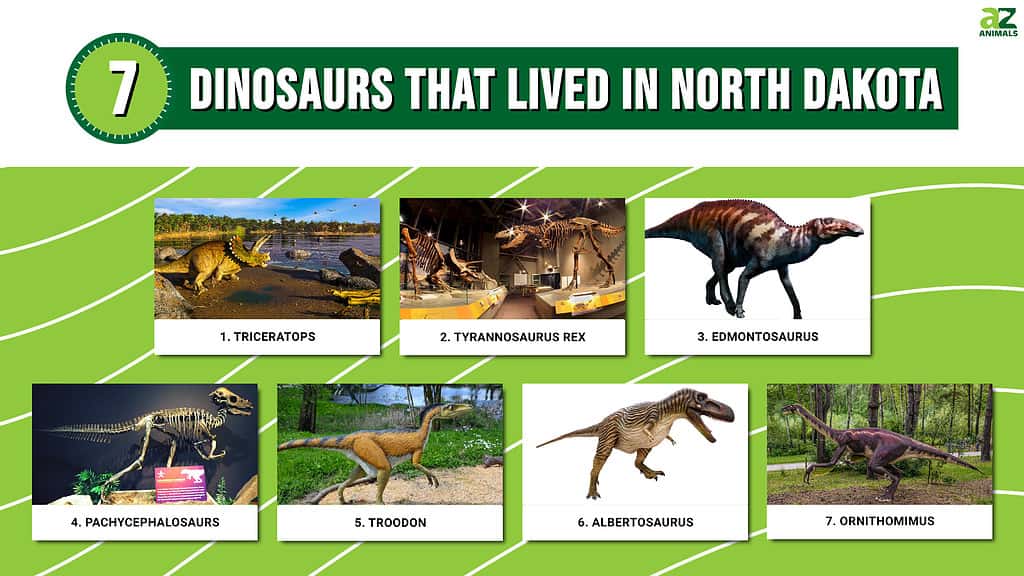
1. Triceratops
A staple of the Late Cretaceous Period, Triceratops was a giant herbivorous dinosaur with three horns on its face and a bony frill around the back of its head. This iconic dinosaur is one of the most famous dinosaurs ever to roam the Earth, and it has also been discovered in North Dakota. Studies suggest that Triceratops were reasonably common in this part of the US around 65 million years ago, leaving behind a trove of fossils and remains that can still be seen today.
This is evident in the famous Hell Creek Formation, located in the northwestern corner of the state and houses several dinosaur bones. A visit to this site can give a unique insight into the long-lost world of these ancient creatures. In Hell Creek, you can find many bones, teeth, and footprints left behind by the Triceratops.
In addition to Hell Creek, the North Dakota Heritage Center in Bismarck also has a wealth of fossils and dinosaur bones that will delight any dino enthusiast. The museum contains a wide range of specimens, including several Triceratops teeth and bones. This is a great way to learn more about this iconic creature and its history in North Dakota.
Those looking to explore the fossilized remains of Triceratops can head to the Museum of Geology at the University of North Dakota. The museum also houses an impressive collection of other dinosaur fossils and artifacts, making it a great place to enjoy a glimpse into the past.
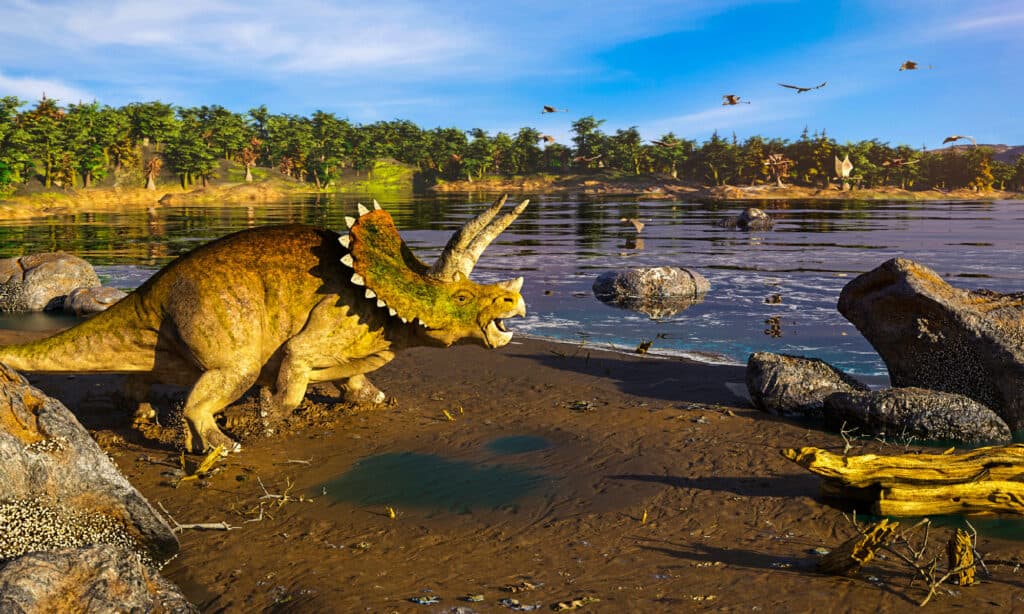
Studies and fossils suggest that Triceratops were reasonably common in North Dakota around 65 million years ago.
©iStock.com/dottedhippo
2. Tyrannosaurus Rex
Possibly the most iconic of all dinosaurs, the T. rex was a massive carnivore and one of the most legendary dinosaurs ever to walk the Earth, and it has also been found in North Dakota. The T. rex lived during the Late Cretaceous Period, 65 – 68 million years ago, and its fossils have been uncovered in the state’s badlands. It is believed that the T. rex, known for its sharp teeth and powerful legs, measured up to 40 feet long and weighed almost 8 tons. It has been suggested that T. rex might have lived in groups, although there is no direct evidence.
Today, visitors to the North Dakota Heritage Center & State Museum in Bismarck can view a full-scale replica of this imposing predator and learn more about its life in the ancient world. They can also see fossilized bones, skulls, and footprints of this incredible species. Both museums have displays of fossils from the T. rex and other species that lived in the region and interactive exhibits about dinosaurs.
A visit to the Theodore Roosevelt National Park in Medora can also give visitors a chance to view the badlands where T. rex fossils were discovered. One can also learn about the region’s prehistoric past by visiting the North Dakota Geological Survey in Grand Forks, which has extensive exhibits on dinosaur life.
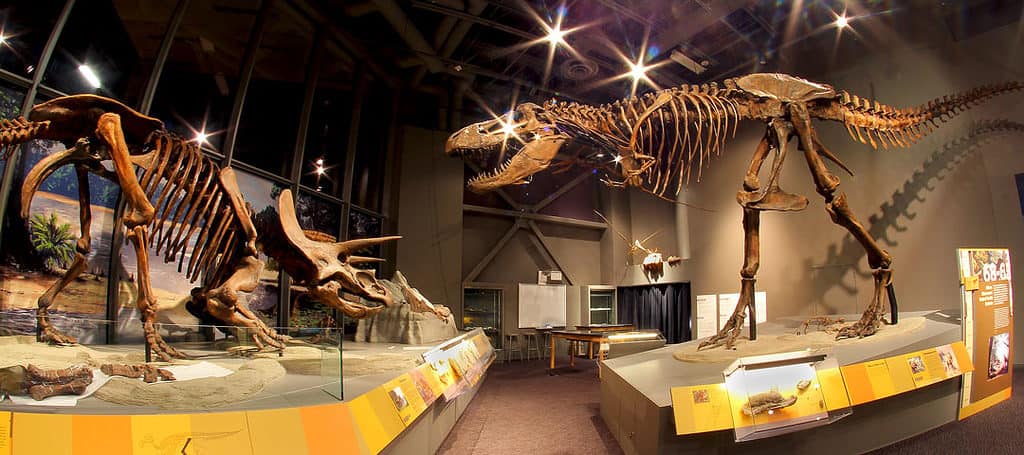
,
©State Historical Society of North Dakota, CC BY 4.0 <https://creativecommons.org/licenses/by/4.0>, via Wikimedia Commons – License
3. Edmontosaurus
Edmontosaurus, also known as the “duck-billed dinosaur,” was a large herbivorous dinosaur that resided in North Dakota during the Late Cretaceous Period. This dinosaur measured up to 30 feet long and weighed nearly 4 tons. Edmontosaurus had a long, narrow snout with hundreds of tiny teeth to help it chew its plant-based diet. The Edmontosaurus also had a prominent crest on its head, which is thought to have been used for display or communication.
Edmontosaurus was a herbivore, and its diet consisted of plants like conifers, ferns, cycads, horsetails, and ginkgoes. Its powerful beak-like jaws let it strip foliage from trees and reach into the ground for roots and tubers. It is thought that the Edmontosaurus may have traveled in herds, as large numbers have been discovered together.
Edmontosaurus fossils have been found in North Dakota, primarily in and around the Hell Creek Formation. Some of the best fossil evidence has been found in Bowman County, where a large number of specimens were discovered between 1997 and 1999. Today, visitors can view these fossils at the Heritage Center Museum in Bismarck. The North Dakota Heritage Center in Bismarck houses a partial skeleton from the Hell Creek Formation. It’s one of the most complete Edmontosaurus skeletons in North America.
Other sites in North Dakota with Edmontosaurus fossils are Dickinson, Richardton, and Bowman County.
Other specimens can be found at the North Dakota Geological Survey’s office in Grand Forks. The Edmontosaurus is one of the most well-known dinosaurs from North Dakota, and its fossils are a source of pride for the state. Visitors to North Dakota can learn more about the Edmontosaurus and its unique characteristics by visiting museums across the state.
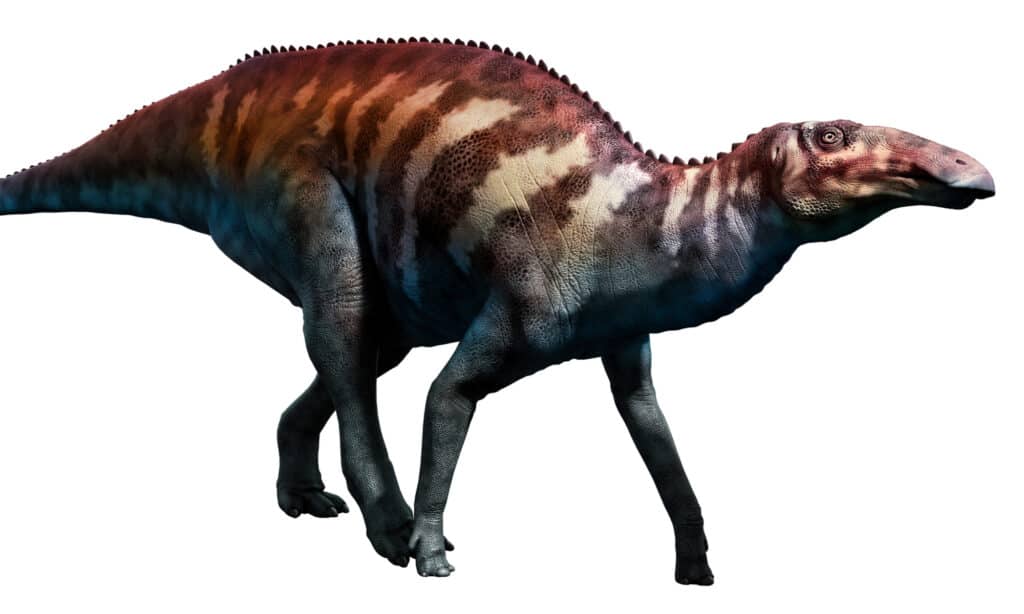
was a large herbivorous dinosaur that resided in North Dakota during the Late Cretaceous Period.
©Warpaint/Shutterstock.com
4. Pachycephalosaurs
This small, bipedal dinosaur had a thick skull roof used to butt against rivals or predators. It lived in the Late Cretaceous Period and had a length of about 6 feet. Its skull roof was typically domed, with an average diameter of 9.8″. The dorsal part of the skull was also often ornamented with spikes and knobs, while the occipital region was generally flat. Its diet consisted of low-lying vegetation, like shrubs and ferns. Pachycephalosaurs are among the few dinosaurs with evidence of ornamentation on their skull, which is a sign that the species had some form of social behavior.
Pachycephalosaurs were herbivorous and primarily ate low-lying vegetation like shrubs and ferns. It was likely a solitary animal, but evidence suggests that the species had some form of social behavior and would butt its thick skull against rivals or predators. Fossil remains of Pachycephalosaurs have been found in several locations across North Dakota, including the Hell Creek Formation.
If you want to see the fossils of Pachycephalosaurs, visit the North Dakota Heritage Center in Bismarck. The museum also has interactive exhibits, educational programs, and even a paleontology lab where visitors can learn more about the ancient creatures. The museum is open year-round. Visitors can also explore Whitaker Bluff, where some of the most impressive dinosaur fossils have been discovered in North Dakota.
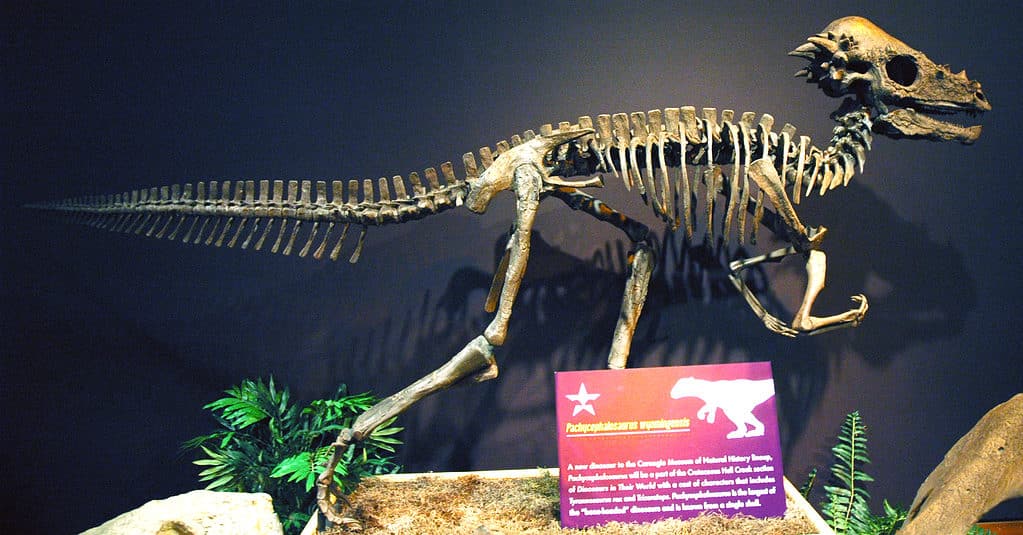
Fossil remains of
Pachycephalosaurshave been found in several locations across North Dakota, including the Hell Creek Formation.
©James St. John, CC BY 2.0 <https://creativecommons.org/licenses/by/2.0>, via Wikimedia Commons – License
5. Troodon
This small, carnivorous dinosaur was one of the more intelligent species of its time. It had a relatively large brain compared to its body size and was thought to have had keen eyesight. Fossil evidence suggests that the Troodon possessed large eyes and a big brain, which helped it evolve some intelligence level.
Troodon was a bipedal dinosaur that measured about 8 feet in length and weighed approximately 110 pounds. It likely had a long, pointed snout and sharp teeth suitable for hunting small prey. It had long arms with three long fingers on each hand, each ending in sharp claws perfect for grasping or ripping prey. Its long, slender legs allowed it to move quickly for hunting and escaping danger.
Fossils of Troodon have been found in the Hell Creek Formation in western North Dakota, dating back to the Late Maastrichtian Stage of the Late Cretaceous period. You can see fossil remains of this species at many museums in the state, such as the North Dakota Heritage Center & State Museum in Bismarck, which houses a large variety of dinosaur fossils from the Hell Creek Formation. The North Dakota Geological Survey in Grand Forks also boasts a collection of Troodon fossils and fossils from other dinosaur species.
For a more in-depth look at Troodon, head to the Theodore Roosevelt National Park nearby. Here you can find the remains of several different species, including Troodon. As you explore the park, keep an eye out for fossilized bones or tracks of this dinosaur.

fossils have been found in several places across North Dakota and suggest that this dinosaur possessed large eyes and a big brain.
©Marcin Polak / CC BY 2.0. – License
6. Albertosaurus
Albertosaurus was a large, carnivorous theropod dinosaur that lived about 66 to 68 million years ago during the Late Cretaceous Period. It was a member of the tyrannosaurid family, including Tyrannosaurus Rex and other related species.
Albertosaurus had a long, low skull and powerful jaws filled with large pointed teeth. The tip of its snout was slightly curved, and its eyes were large, giving it excellent vision. Its arms were short and had two fingers with claws on each hand. Albertosaurus was about 26 feet long and weighed around 1,200 to 4,000 pounds.
Albertosaurus was a scavenger and predator; it mainly hunted small prey such as mammals, small dinosaurs, birds, and fish but could also attack large dinosaurs. It was an active predator and would hunt by chasing its prey down. Fossil evidence suggests that Albertosaurus may have even hunted in packs, working together to bring down larger prey.
Fossil remains of Albertosaurus have been discovered in the Hell Creek Formation in North Dakota, as well as in Alberta and Montana. There are several museums in the state, such as the North Dakota Heritage Center and the North Dakota Geological Survey, where you can learn about Albertosaurus. The Museum of Natural History in Minneapolis, Minnesota, is also home to some Albertosaurus fossils.
The University of North Dakota also has a fossil collection featuring specimens of Albertosaurus and other North Dakota dinosaurs.
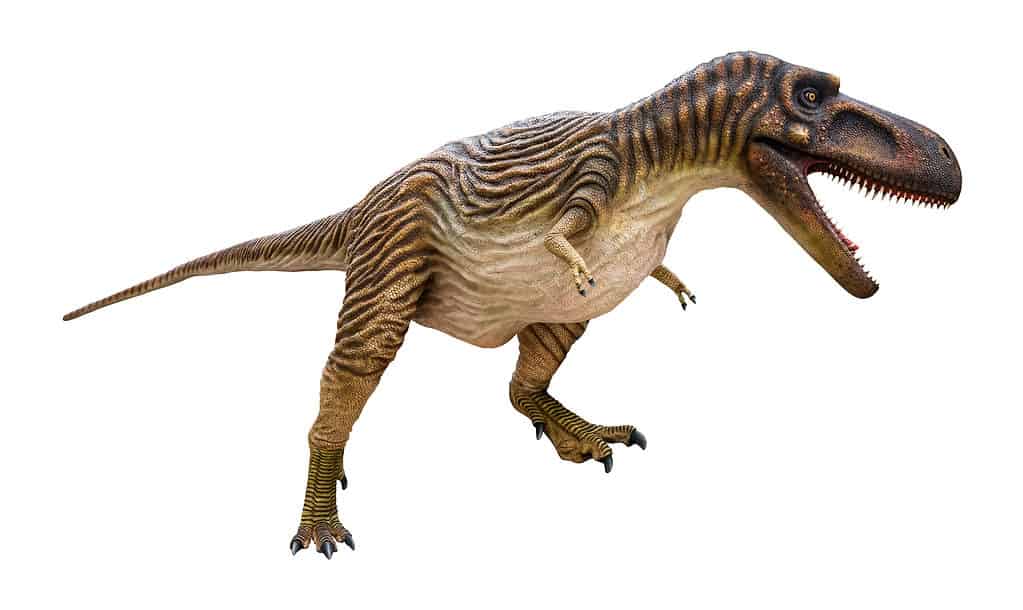
mainly hunted small prey such as mammals, small dinosaurs, birds, and fish but could also attack large dinosaurs.
©YuRi Photolife/Shutterstock.com
7. Ornithomimus
Ornithomimus, meaning “bird mimic,” was a small theropod dinosaur that lived in what is now North Dakota during the Late Cretaceous Period. Due to its long legs and lightweight body, it was a swift runner with a skull shape similar to modern birds, which allowed it to eat plant and animal matter. Ornithomimus had a downy covering of feathers and a long tail with a fan of feathers at the end.
Ornithomimus had an omnivorous diet. Its long legs and fast running speed allowed it to catch small prey, such as lizards and other small animals. It also ate fruits, seeds, and leaves from low-lying vegetation. Ornithomimus was a social animal and often lived in large herds.
It was likely an active predator chasing down its prey. It was also fast enough to escape from larger predators like Tyrannosaurus Rex.
Fossils of Ornithomimus have been found in various sites throughout North Dakota, including near the towns of Bowman, Sentinel Butte, and Turtle Lake. The dinosaur fossils can be seen on display at the North Dakota Heritage Center in Bismarck, North Dakota.
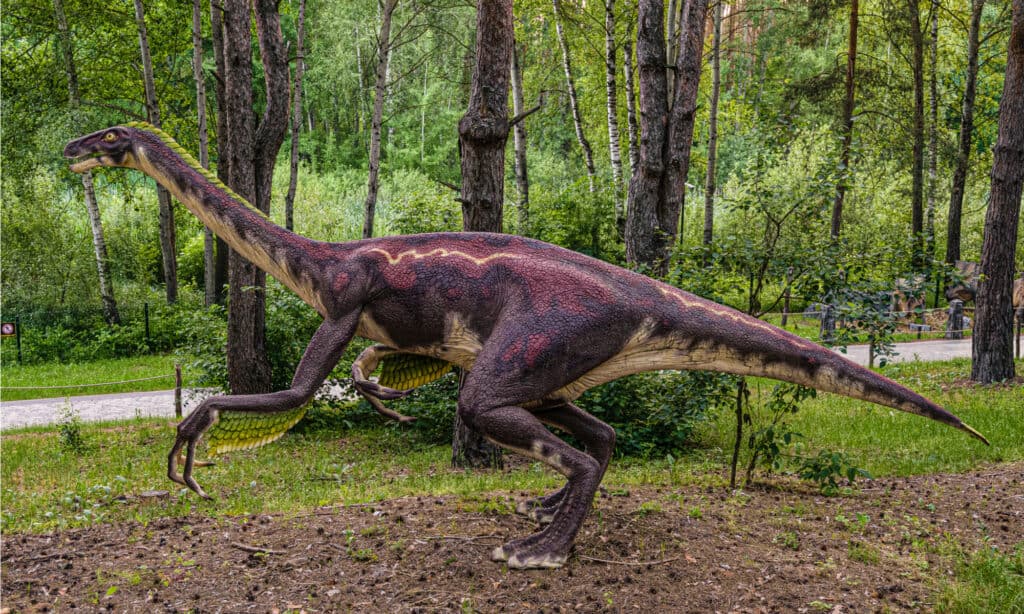
Fossils of
Ornithomimushave been found in various sites throughout North Dakota.
©N-sky/Shutterstock.com
Final Thoughts
North Dakota is a great place to explore and learn about the dinosaurs that once roamed the earth. Its diverse array of dinosaur species and numerous fossil sites make it the perfect destination for any dinosaur enthusiast. From Albertosaurus to Ornithomimus, you can find fossils of some of the most fascinating creatures ever.
Whether you’re a dinosaur enthusiast or just looking for an exciting day out, visiting a museum and learning about the dinosaurs that once lived in North Dakota is sure to be an informative and enjoyable experience.
Summary of 7 Dinosaurs that Lived in North Dakota (And Where to See Fossils Today)
| Rank | Dinosaur | Where to See Fossils |
|---|---|---|
| 1 | Triceratops | Museum of Geology at the University of North Dakota |
| 2 | Tyrannosaurus | North Dakota Heritage Center & State Museum in Bismarck |
| 3 | Edmontosaurus | Museums across the state |
| 4 | Pachycephalosaurs | North Dakota Heritage Center in Bismarck |
| 5 | Troodon | North Dakota Heritage Center & State Museum in Bismarck |
| 6 | Albertosaurus | Hell Creek Formation in North Dakota, as well as in Alberta and Montana. |
| 7 | Ornithomimus | North Dakota Heritage Center in Bismarck |
The photo featured at the top of this post is © iStock.com/CoreyFord
Sources
- West Central Tribune, Available here: https://www.wctrib.com/news/newly-uncovered-north-dakota-fossils-could-stir-t-rex-vs-nanotyrannus-debate
- KX News, Available here: https://www.kxnet.com/news/state-news/see-how-many-dinosaur-fossils-are-in-north-dakota
- North Dakota Tourism, Available here: https://www.ndtourism.com/best-places/8-stops-north-dakota-dinosaur-tour
- Britannica, Available here: https://www.britannica.com/topic/Sue
Thank you for reading! Have some feedback for us? Contact the AZ Animals editorial team.






